 The history of Nuapada is inextricably connected with the district of Kalahandi, since Nuapada has survived as a part of Kalahandi for long. It is believed that the District of Kalahandi formed in ancient time a part of Mahakantara territory. But the historical credentials of the region are documented from the period when Samudragupta led a military campaign of the region in 4th century B.C. During this period a king named Vyaghraraja was ruling over Mahakantara. According to the copperplates and the gold coins Nuapada area in the 6th century was under the kings of Sarabhapuriya dynasty. This region came under the occupation of the Somavamsis of South Kosala during the 8th century A.D. when Mahaivagupta Balarjuna was ruling from his headquarters at Sripur. Therefore as is evident from the historical records of the Nuapada, that a number of dynasties had inhabited the region right from its advent.
The history of Nuapada is inextricably connected with the district of Kalahandi, since Nuapada has survived as a part of Kalahandi for long. It is believed that the District of Kalahandi formed in ancient time a part of Mahakantara territory. But the historical credentials of the region are documented from the period when Samudragupta led a military campaign of the region in 4th century B.C. During this period a king named Vyaghraraja was ruling over Mahakantara. According to the copperplates and the gold coins Nuapada area in the 6th century was under the kings of Sarabhapuriya dynasty. This region came under the occupation of the Somavamsis of South Kosala during the 8th century A.D. when Mahaivagupta Balarjuna was ruling from his headquarters at Sripur. Therefore as is evident from the historical records of the Nuapada, that a number of dynasties had inhabited the region right from its advent.
In the 9th century A.D, when Somavansis were ousted from this region, a new kingdom called Sonepur-Sambalpur was organized; the region of Kalahandi still continued to be the part of the Somavansi Empire. However as the past history of Nuapada demonstrates the ancient region of Kalahandi has passed on to the hands of different kings belonging to different dynasties.
The Gangas ruled Orissa including the region of Kalahandi for longest period till the arrival of the British in India. If the historical sources are to be believed it may be said that the Nagas ruled over Kamalmandala as feudatories of the Gangas till 14th century A.D. after which they owed allegiance to the Surjayavamsi Gajapatis. The exact time has not been yet deciphered by the historians that when Kamalmandala became known as Kalahandi. The earliest reference to the name Kalahandi is found in the Dadhivaman temple inscription dated in Yugabda 4819, i.e., A.D. 1718. As far as the historical records of Nuapada is concerned, in 1905, the district of Sambalpur with all its units including Kalahandi was merged with the province of Orissa When the province of Orissa was formed in 1936, the British Government reorganized the districts, both feudatory and princely, which are to be annexed with the Orissa province. On the 1st January 1948, Kalahandi along with other feudatory states of Orissa except Mayurbhanj merged with Orissa and the new District of Kalahandi was formed with the ex-states of Kalahandi, Patna and Sonepur. Finally on 1st November 1949, Patna and Sonepur separated from the erstwhile Kalahandi district together constituted a separate District and the Nuapada sub-division of Sambalpur was added to the District of Kalahandi.



















